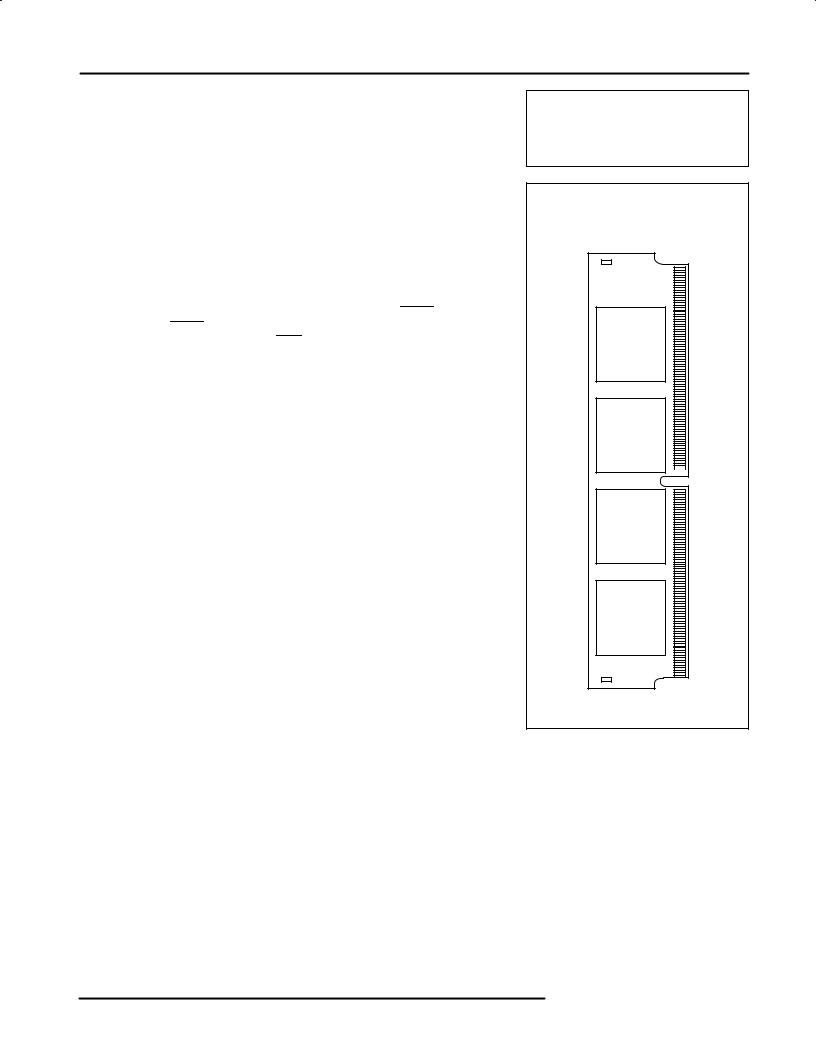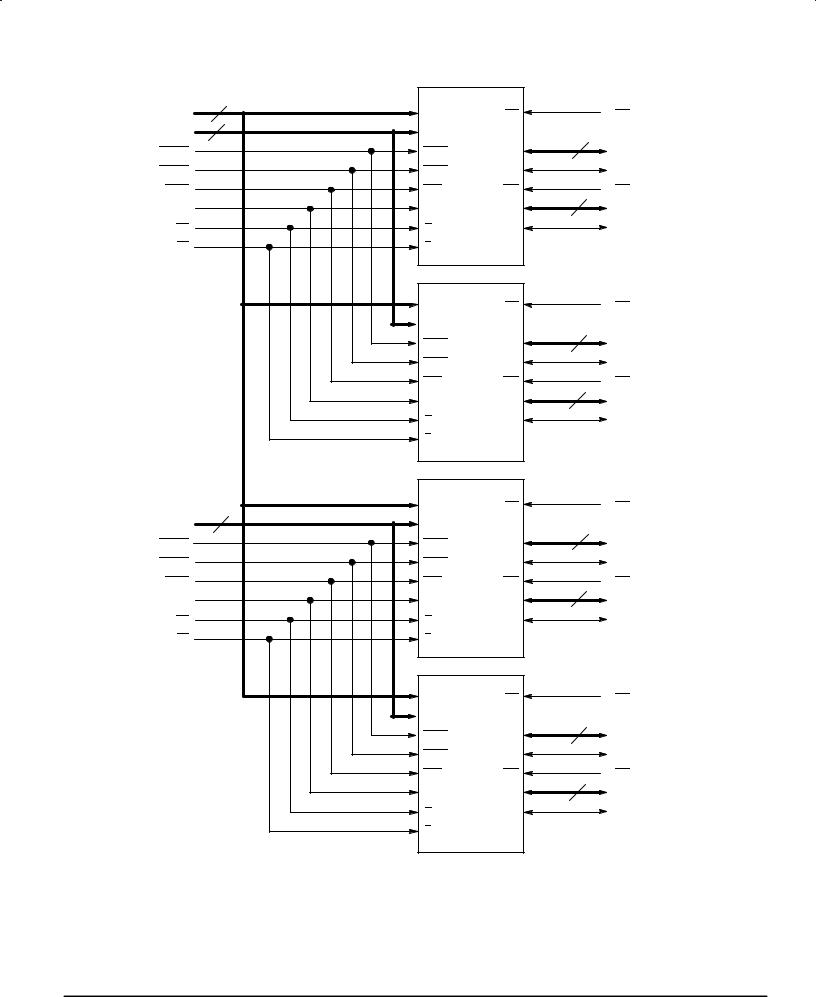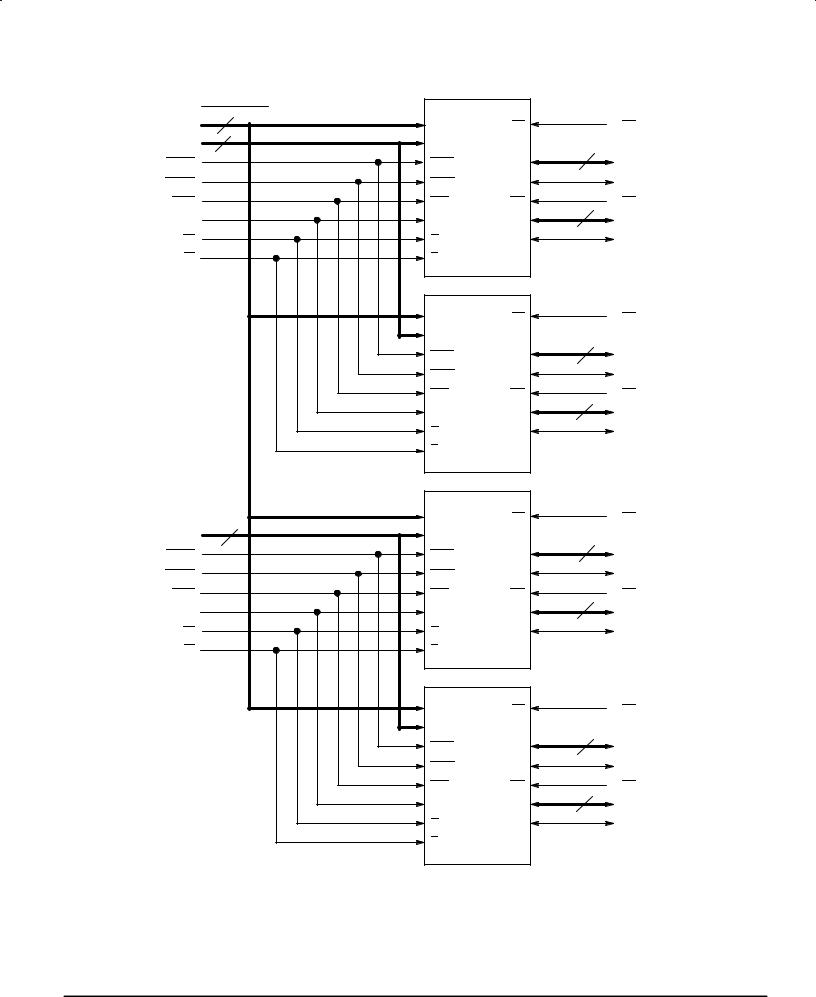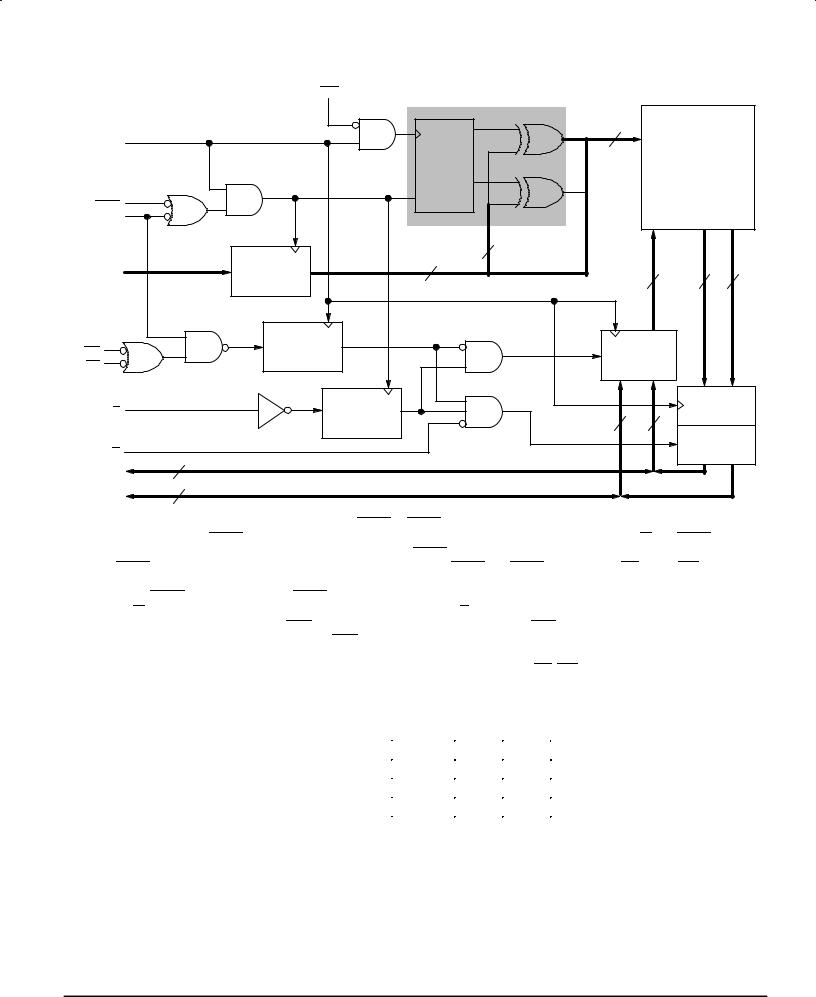Motorola MCM72CB64SG80, MCM72CB64SG100, MCM72CB32SG66, MCM72CB64SG66, MCM72CB32SG80 Datasheet
...
MOTOROLA
SEMICONDUCTOR TECHNICAL DATA
Order this document by MCM72CB32/D
256KB and 512KB BurstRAM
Secondary Cache Module for Pentium
The MCM72CB32SG and MCM72CB64SG are designed to provide a burstable, high performance, 256K/512K L2 cache for the Pentium microprocessor. The modules are configured as 32K x 72 and 64K x 72 bits in a 160 pin card edge memory module. The module uses four of Motorola's MCM67C518 or MCM67C618 BiCMOS BurstRAMs.
Bursts can be initiated with either address status processor (ADSP) or address status controller (ADSC). Subsequent burst addresses are generated internal to the BurstRAM by the burst advance (ADV) input pin.
Write cycles are internally self timed and are initiated by the rising edge of the clock (K) input. Eight write enables are provided for byte write control.
The cache family is designed to interface with popular Pentium cache controllers with on board tag.
PD0 ± PD2 are reserved for density and speed identification.
•Pentium±style Burst Counter on Board
•160 Pin Card Edge Module
•Single 5 V ± 5% Power Supply
•All Inputs and Outputs are TTL Compatible
•Three State Outputs
•Byte Parity
•Byte Write Capability
•Fast Module Clock Rates: 66 MHz, 80 MHz, 100 MHz
•Decoupling Capacitors for each Fast Static RAM
•High Quality Multi±Layer FR4 PWB With Separate Power and Ground Planes
•I/Os are 3.3 V Compatible
•Burndy Connector, Part Number: CELP2X80SC3Z48
BurstRAM is a trademark of Motorola.
Pentium is a trademark of Intel Corp.
MCM72CB32
MCM72CB64
160±LEAD CARD EDGE CASE 1113±01 TOP VIEW
1


 42
42
43
80
REV 1 5/95
Motorola, Inc. 1995

PIN ASSIGNMENT
160±LEAD CARD EDGE MODULE
TOP VIEW
|
|
|
Cache |
|
PD2 |
PD1 |
PD0 |
Size |
Module |
|
|
|
|
|
VSS |
VSS |
NC |
256KB |
72CB32SG |
VSS |
VSS |
VSS |
512KB |
72CB64SG |
|
|
|
|
|
|
|
|
|
|
|
|
|
|
|
|
|
|
|
|
PIN NAMES |
|
|
|
||||||||||||||||||
|
A3 ± A18 . . . . . . . |
. . . . . . . . . . . . . . . Address Inputs |
||||||||||||||||||
|
K0, K1 . . . . . . . . . . |
. . . . . . . . . . . . . . . . . . . . . . Clock |
||||||||||||||||||
|
|
|
|
± |
|
|
|
|
|
|
|
|
|
|
|
|
|
Byte Write |
||
|
W0 |
|
W7 |
|||||||||||||||||
|
E0, |
|
|
E1 |
|
|
|
|
. |
|
. . . . |
. . . |
|
. . |
. . . . . . . . . . . . . . Module Enable |
|||||
|
G0, |
|
G1 |
|
|
. |
|
. . . . |
. . . |
|
. . |
. . . . . . . Module Output Enable |
||||||||
|
DQ0 ± DQ63 . . . . . |
. . . . . Cache Data Input/Output |
||||||||||||||||||
|
DQP0 ± DQP7 . . . |
. . . . . . Data Parity Input/Output |
||||||||||||||||||
|
|
|
|
|
|
|
|
|
|
|
Controller Address Status |
|||||||||
|
ADSC0, |
ADSC1 |
||||||||||||||||||
|
ADSP0, |
|
ADSP1 |
. . |
. . . . Processor Address Status |
|||||||||||||||
|
ADV0, |
|
ADV1 |
. . . . . |
. . . . . . . . . . . . . . Burst Advance |
|||||||||||||||
|
PD0 ± PD2 . . . . . . |
. . . . . . . . . . . . Presence Detect |
||||||||||||||||||
|
VCC5 . . . . . . . . . . . |
. . . . . . . . . . + 5 V Power Supply |
||||||||||||||||||
|
VSS . . . . . . . . . . . . |
. . . . . . . . . . . . . . . . . . . . Ground |
||||||||||||||||||
*No Connect for MCM72CB32/MCM72CB64
**No Connect for MCM72CB32
|
VSS |
81 |
1 |
|
VSS |
||
DQ63 |
82 |
2 |
|
DQ62 |
|||
VCC5 |
83 |
3 |
|
VCC3* |
|||
DQ61 |
84 |
4 |
|
DQ60 |
|||
VCC5 |
85 |
5 |
|
VCC3* |
|||
DQ59 |
86 |
6 |
|
DQ58 |
|||
DQ57 |
87 |
7 |
|
DQ56 |
|||
|
VSS |
88 |
8 |
|
VSS |
||
DQP7 |
89 |
9 |
|
DQP6 |
|||
DQ55 |
90 |
10 |
|
DQ54 |
|||
DQ53 |
91 |
11 |
|
DQ52 |
|||
DQ51 |
92 |
12 |
|
DQ50 |
|||
|
VSS |
93 |
13 |
|
VSS |
||
DQ49 |
94 |
14 |
|
DQ48 |
|||
DQ47 |
95 |
15 |
|
DQ46 |
|||
DQ45 |
96 |
16 |
|
DQ44 |
|||
DQ43 |
97 |
17 |
|
DQ42 |
|||
|
VSS |
98 |
18 |
|
VSS |
||
DQ41 |
99 |
19 |
|
DQ40 |
|||
DQP5 |
100 |
20 |
|
DQP4 |
|||
DQ39 |
101 |
21 |
|
DQ38 |
|||
DQ37 |
102 |
22 |
|
DQ36 |
|||
DQ35 |
103 |
23 |
|
DQ34 |
|||
|
VSS |
104 |
24 |
|
VSS |
||
DQ33 |
105 |
25 |
|
DQ32 |
|||
DQ31 |
106 |
26 |
|
DQ30 |
|||
DQ29 |
107 |
27 |
|
DQ28 |
|||
DQ27 |
108 |
28 |
|
DQ26 |
|||
DQ25 |
109 |
29 |
|
DQ24 |
|||
|
VSS |
110 |
30 |
|
VSS |
||
DQP3 |
111 |
31 |
|
DQP2 |
|||
DQ23 |
112 |
32 |
|
DQ22 |
|||
DQ21 |
113 |
33 |
|
DQ20 |
|||
VCC5 |
114 |
34 |
|
VCC3* |
|||
DQ19 |
115 |
35 |
|
DQ18 |
|||
|
VSS |
116 |
36 |
|
VSS |
||
DQ17 |
117 |
37 |
|
DQ16 |
|||
VCC5 |
118 |
38 |
|
VCC3* |
|||
DQ15 |
119 |
39 |
|
DQ14 |
|||
DQ13 |
120 |
40 |
|
DQ12 |
|||
|
VSS |
121 |
41 |
|
VSS |
||
|
DQ11 |
122 |
42 |
|
DQ10 |
||
VCC5 |
123 |
43 |
|
VCC3* |
|||
|
DQ9 |
124 |
44 |
|
DQ8 |
||
DQP1 |
125 |
45 |
|
DQP0 |
|||
VCC5 |
126 |
46 |
|
VCC3* |
|||
|
DQ7 |
127 |
47 |
|
DQ6 |
||
|
DQ5 |
128 |
48 |
|
DQ4 |
||
|
DQ3 |
129 |
49 |
|
DQ2 |
||
|
DQ1 |
130 |
50 |
|
DQ0 |
||
|
VSS |
131 |
51 |
|
VSS |
||
|
A3B |
132 |
52 |
|
A3A |
||
|
A4B |
133 |
53 |
|
A4A |
||
|
A5B |
134 |
54 |
|
A5A |
||
|
A6B |
135 |
55 |
|
A6A |
||
|
A7 |
136 |
56 |
|
A8 |
||
|
VSS |
137 |
57 |
|
VSS |
||
|
A9 |
138 |
58 |
|
A10 |
||
|
A11 |
139 |
59 |
|
A12 |
||
|
A13 |
140 |
60 |
|
A14 |
||
|
A15 |
141 |
61 |
|
A16 |
||
|
A17 |
142 |
62 |
|
A18** |
||
|
VSS |
143 |
63 |
|
VSS |
||
|
*A19 |
144 |
64 |
|
PD0 |
||
|
PD1 |
145 |
65 |
|
PD2 |
||
|
K0 |
146 |
66 |
|
K1 |
||
|
*K2 |
147 |
67 |
|
K3* |
||
|
VSS |
|
148 |
68 |
|
VSS |
|
|
WE7 |
149 |
69 |
|
WE6 |
||
|
WE5 |
150 |
70 |
|
WE4 |
||
|
WE3 |
151 |
71 |
|
WE2 |
||
|
WE1 |
152 |
72 |
|
WE0 |
||
|
VSS |
|
153 |
73 |
|
VSS |
|
ADSC1 |
154 |
74 |
|
ADSC0 |
|||
|
E1 |
|
155 |
75 |
|
E0 |
|
ADV1 |
156 |
76 |
|
ADV0 |
|||
|
G1 |
157 |
77 |
|
G0 |
||
VCC5 |
|
158 |
78 |
|
VCC3* |
||
ADSP1 |
159 |
79 |
|
ADSP0 |
|||
|
VSS |
160 |
80 |
|
VSS |
||
MCM72CB32•MCM72CB64 |
MOTOROLA FAST SRAM |
2 |
|

|
|
64K x 72 BurstRAM MEMORY MODULE BLOCK DIAGRAM |
|
||
|
12 |
MCM67C618 |
|
||
A7 ± A18 |
A4 ± A15 |
LW |
W0 |
||
4 |
|||||
A3A ± A6A |
A0 ± A3 |
|
|
||
|
8 |
|
|||
ADSP0 |
|
ADSP |
|
||
|
DQ0 ± DQ7 |
DQ0 ± DQ7 |
|||
ADSC0 |
|
ADSC |
DQ8 |
DQP0 |
|
ADV0 |
|
ADV |
UW |
W1 |
|
|
|
|
8 |
DQ8 ± DQ15 |
|
K0 |
|
K |
DQ9 ± DQ16 |
||
G0 |
|
G |
DQ17 |
DQP1 |
|
E0 |
|
E |
|
|
|
|
|
MCM67C618 |
|
||
|
|
A4 ± A15 |
LW |
W2 |
|
|
|
A0 ± A3 |
8 |
|
|
|
|
ADSP |
|
||
|
|
DQ0 ± DQ7 |
DQ16 ± DQ23 |
||
|
|
ADSC |
DQ8 |
DQP2 |
|
|
|
ADV |
UW |
W3 |
|
|
|
|
8 |
DQ24 ± DQ31 |
|
|
|
K |
DQ9 ± DQ16 |
||
|
|
G |
DQ17 |
DQP3 |
|
|
|
E |
|
|
|
|
|
MCM67C618 |
|
||
|
4 |
A4 ± A15 |
LW |
W4 |
|
A3B ± A6B |
A0 ± A3 |
|
|
||
|
8 |
|
|||
ADSP1 |
|
ADSP |
|
||
|
DQ0 ± DQ7 |
DQ32 ± DQ39 |
|||
ADSC1 |
|
ADSC |
DQ8 |
DQP4 |
|
ADV1 |
|
ADV |
UW |
W5 |
|
|
|
|
8 |
DQ40 ± DQ47 |
|
K1 |
|
K |
DQ9 ± DQ16 |
||
G1 |
|
G |
DQ17 |
DQP5 |
|
E1 |
|
E |
|
|
|
|
|
MCM67C618 |
|
||
|
|
A4 ± A15 |
LW |
W6 |
|
|
|
A0 ± A3 |
8 |
|
|
|
|
ADSP |
|
||
|
|
DQ0 ± DQ7 |
DQ48 ± DQ55 |
||
|
|
ADSC |
DQ8 |
DQP6 |
|
|
|
ADV |
UW |
W7 |
|
|
|
|
8 |
DQ56 ± DQ63 |
|
|
|
K |
DQ9 ± DQ16 |
||
|
|
G |
DQ17 |
DQP7 |
|
|
|
E |
|
|
|
MOTOROLA FAST SRAM |
MCM72CB32•MCM72CB64 |
|
3 |

|
32K x 72 BurstRAM MEMORY MODULE BLOCK DIAGRAM |
|
|||
A18 |
NC |
MCM67C518 |
|
||
A7 ± A17 |
11 |
A4 ± A14 |
LW |
W0 |
|
4 |
|||||
A3A ± A6A |
A0 ± A3 |
|
|
||
|
8 |
|
|||
ADSP0 |
|
ADSP |
|
||
|
DQ0 ± DQ7 |
DQ0 ± DQ7 |
|||
ADSC0 |
|
ADSC |
DQ8 |
DQP0 |
|
ADV0 |
|
ADV |
UW |
W1 |
|
|
|
|
8 |
DQ8 ± DQ15 |
|
K0 |
|
K |
DQ9 ± DQ16 |
||
G0 |
|
G |
DQ17 |
DQP1 |
|
E0 |
|
E |
|
|
|
|
|
MCM67C518 |
|
||
|
|
A4 ± A14 |
LW |
W2 |
|
|
|
A0 ± A3 |
8 |
|
|
|
|
ADSP |
|
||
|
|
DQ0 ± DQ7 |
DQ16 ± DQ23 |
||
|
|
ADSC |
DQ8 |
DQP2 |
|
|
|
ADV |
UW |
W3 |
|
|
|
|
8 |
DQ24 ± DQ31 |
|
|
|
K |
DQ9 ± DQ16 |
||
|
|
G |
DQ17 |
DQP3 |
|
|
|
E |
|
|
|
|
|
MCM67C518 |
|
||
|
4 |
A4 ± A14 |
LW |
W4 |
|
A3B ± A6B |
A0 ± A3 |
|
|
||
|
8 |
|
|||
ADSP1 |
|
ADSP |
|
||
|
DQ0 ± DQ7 |
DQ32 ± DQ39 |
|||
ADSC1 |
|
ADSC |
DQ8 |
DQP4 |
|
ADV1 |
|
ADV |
UW |
W5 |
|
|
|
|
8 |
DQ40 ± DQ47 |
|
K1 |
|
K |
DQ9 ± DQ16 |
||
G1 |
|
G |
DQ17 |
DQP5 |
|
E1 |
|
E |
|
|
|
|
|
MCM67C518 |
|
||
|
|
A4 ± A14 |
LW |
W6 |
|
|
|
A0 ± A3 |
8 |
|
|
|
|
ADSP |
|
||
|
|
DQ0 ± DQ7 |
DQ48 ± DQ55 |
||
|
|
ADSC |
DQ8 |
DQP6 |
|
|
|
ADV |
UW |
W7 |
|
|
|
|
8 |
DQ56 ± DQ63 |
|
|
|
K |
DQ9 ± DQ16 |
||
|
|
G |
DQ17 |
DQP7 |
|
|
|
E |
|
|
|
MCM72CB32•MCM72CB64 |
MOTOROLA FAST SRAM |
4 |
|

|
MCM67C618 BLOCK DIAGRAM (See Note) |
|
|
|
||
|
ADV |
BURST LOGIC |
|
|
|
|
|
|
|
|
|
||
|
|
|
|
INTERNAL |
|
|
K |
|
Q0 |
A0′ |
ADDRESS |
|
|
BINARY COUNTER |
Q1 |
A0 |
16 |
ARRAY |
||
|
A1′ |
|||||
|
|
|
|
64K |
×18 |
|
|
|
|
|
|
MEMORY |
|
ADSC |
CLR |
|
A1 |
|
|
|
|
|
|
|
|
|
|
ADSP |
|
|
|
|
|
|
|
A1 ± A0 |
2 |
|
|
|
|
|
A2 ± A15 |
|
|
|
||
A0 ± A15 |
ADDRESS |
|
|
|
|
|
REGISTER |
|
|
18 |
9 |
9 |
|
|
|
|
||||
|
16 |
|
|
|||
|
|
|
|
|
|
|
UW |
WRITE |
|
|
DATA±IN |
|
|
REGISTER |
|
|
|
|||
LW |
|
|
|
REGISTERS |
|
|
|
|
|
|
|
|
|
E |
ENABLE |
|
|
|
DATA±OUT |
|
|
|
|
REGISTERS |
|||
REGISTER |
|
|
|
|||
|
|
|
9 |
9 |
|
|
|
|
|
|
|
||
|
|
|
|
|
|
OUTPUT |
G |
|
|
|
|
|
BUFFER |
9 |
|
|
|
|
|
|
DQ0 ± DQ8 |
|
|
|
|
|
|
|
|
|
|
|
|
|
DQ9 ± DQ17 |
9 |
|
|
|
|
|
|
|
|
|
|
|
|
NOTE: All registers are positive±edge triggered. The ADSC or ADSP signals control the duration of the burst and the start of the next burst. When ADSP is sampled low, any ongoing burst is interrupted and a read (independent of W and ADSC) is performed using the new external address. Alternatively, an ADSP±initiated two cycle WRITE can be performed by asserting ADSP and a valid address on the first cycle, then negating both ADSP and ADSC and asserting LW and/or UW with valid data on the second cycle (see Single Write Cycle in WRITE CYCLES timing diagram).
When ADSC is sampled low (and ADSP is sampled high), any ongoing burst is interrupted and a read or write (dependent on W) is performed using the new external address. Chip enable (E) is sampled only when a new base address is loaded. After the first cycle of the burst, ADV controls subsequent burst cycles. When ADV is sampled low, the internal address is advanced prior to the operation. When ADV is sampled high, the internal address is not advanced, thus inserting a wait state into the burst sequence accesses. Upon completion of a burst, the address will wrap around to its initial state. See BURST SEQUENCE TABLE. Write refers to either or both byte write enables (LW, UW).
BURST SEQUENCE TABLE (See Note)
External Address |
A15 ± A2 |
A1 |
|
A0 |
|||
|
|
|
|
|
|
|
|
1st Burst Address |
A15 ± A2 |
A1 |
|
|
|
||
|
A0 |
||||||
2nd Burst Address |
A15 ± A2 |
|
|
|
|
A0 |
|
A1 |
|
||||||
3rd Burst Address |
A15 ± A2 |
|
|
|
|
|
|
A1 |
|
A0 |
|||||
NOTE: The burst wraps around to its initial state upon completion.
MOTOROLA FAST SRAM |
MCM72CB32•MCM72CB64 |
|
5 |
